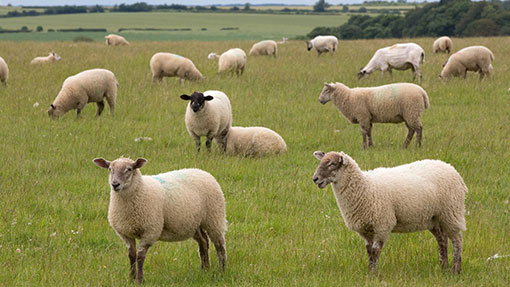Monthly must dos: Batch lambs by weight to target feed efficiently

Beef and sheep
Finish lambs efficiently
It’s important to batch lambs according to weight so that feed can be targeted more efficiently, according to Eblex’s Katie Brian.
“Working out what feed is available and how much is needed to feed the lambs simplifies management decisions and improves efficiency,” she says.
“Whatever crop is being fed, the principles of planning feed allocation remain the same. A feed budget which takes into consideration changes in numbers and weight can be used to estimate how much feed is required.
“Knowing the costs of both animals and feeds is essential when deciding to buy or sell stores, or finish home-produced lambs.”
For more information see the Eblex Better Returns manual Growing and Finishing Lambs for Better Returns.
Expand your knowledge with Eblex BRP+
The Eblex Better Returns Programme Plus (BRP+) range of online publications is ideal for beef and sheep producers looking for in-depth information on specialist topics.
“The content of these documents draws on research and farm practice, and often incorporates farmer case studies,” says Eblex communications manager Jo Biggs.
“The key messages are highlighted on the front page and throughout the document, making them easy to browse.
“The BRP+ series has grown significantly over the past year. The newest document to be published looks at artificial insemination (AI) and oestrus synchronisation of beef cattle.”
The BRP+ documents can be found at on the Eblex website .
Dairy
Learning doesn’t stop on graduation day
Starting your last year at college and wondering what to do when it’s all over? If you don’t have a dairy farm to go home to, it is now possible to get into dairy farm business ownership via a joint venture , says DairyCo extension officer Shirley Macmillan.
“This is where a farm owner teams up with a self-employed contractor – you. Together, they run a dairy farm and split the profits in an agreed ratio. Contractors supply the labour, management input, machinery and, sometimes, livestock. This is why a joint venture isn’t like applying for a top job.
“Contractors need to be able to make a difference to a dairy farming business, resulting in more profit, so there is a lot of practical experience to build up first, plus business and financial knowledge.
“Learning doesn’t, therefore, stop on graduation day. Spend your final year in college planning your next steps. Check out the DairyCo website, where you can download its joint venture report, which explains in detail how they work, plus templates of contracts. There is also advice on how to plan your career path.
“This includes networking and visiting the right sort of business-minded dairy farms, gaining overseas farming experience, and collecting technical skills from AI to foot trimming. Personal development and people skills are equally important, as is good financial awareness.”
Ensure labour efficiency
With margins set for a squeeze this winter, this month’s must-do surely must be streamlining your business to the max, says DairyCo extension officer Izak van Heerden.
“One way is to ensure labour efficiency. To achieve this, ensure all members of the team understand the business strategy and objectives. Gear everything towards optimum cow health from cow accommodation, layout, materials and feeding, through to lighter workloads.
“Efficient standard operating procedures can be invaluable to achieve this, but the whole team needs to buy into the protocols. Make sure winter routines are revised now and keep fine-tuning them in weekly meetings with all staff.
“Make sure labour efficiency is always at the back of your mind when making decisions and think about applying lean management tools across all planning and implementation. For more information, visit the DairyCo website .”
Pigs
Keep momentum on finisher herd performance
Finisher pig producers need to keep focused on key factors to continue positive performance trends, says Stephen Winfield, BPEX knowledge transfer manager.
Finishing herd feed conversion ratio was 2.66, rearing herd growth was 511g/day and finishing herd growth was 800g/day, according to Agrosoft data for the year to June 2014.
Improved feed, timing on ration changes, water availability, water quality and investments in better building ventilation will all have contributed to the gains to date. Strong weaning weights, stocking rates, weighing and recording are also important.
The wean-to-finish section on the BPEX Practical Pig App has short on-farm video clips to help demonstrate important tasks to staff. The clips can also be viewed on the website .
Get on course with pig skills
Skilled, enthusiastic people are the most important part of a successful business and there is a range of ways for everyone in the pig industry to train and learn new skills at every level, from new stockperson through to unit manager.
BPEX skills development co-ordinator Samantha Bowsher says this year’s courses get under way around the country from October onwards, so look out for a BPEX booklet with all the information, dates and locations, which will be available online shortly. Course costs are subsidised by BPEX. Visit the website
Veterinary tasks
Routine jobs for October should include postnatal and pre-breeding checks for autumn-calving herds so any ovarian disorders or uterine infections can be treated before the service period begins.
Many flocks will have had a ram in for some time now, so it’s also a good time to check his weight in case he requires any feeding change, and raddle fitting to prevent sores.
For an up-to-date parasite forecast, visit the Nadis website.
